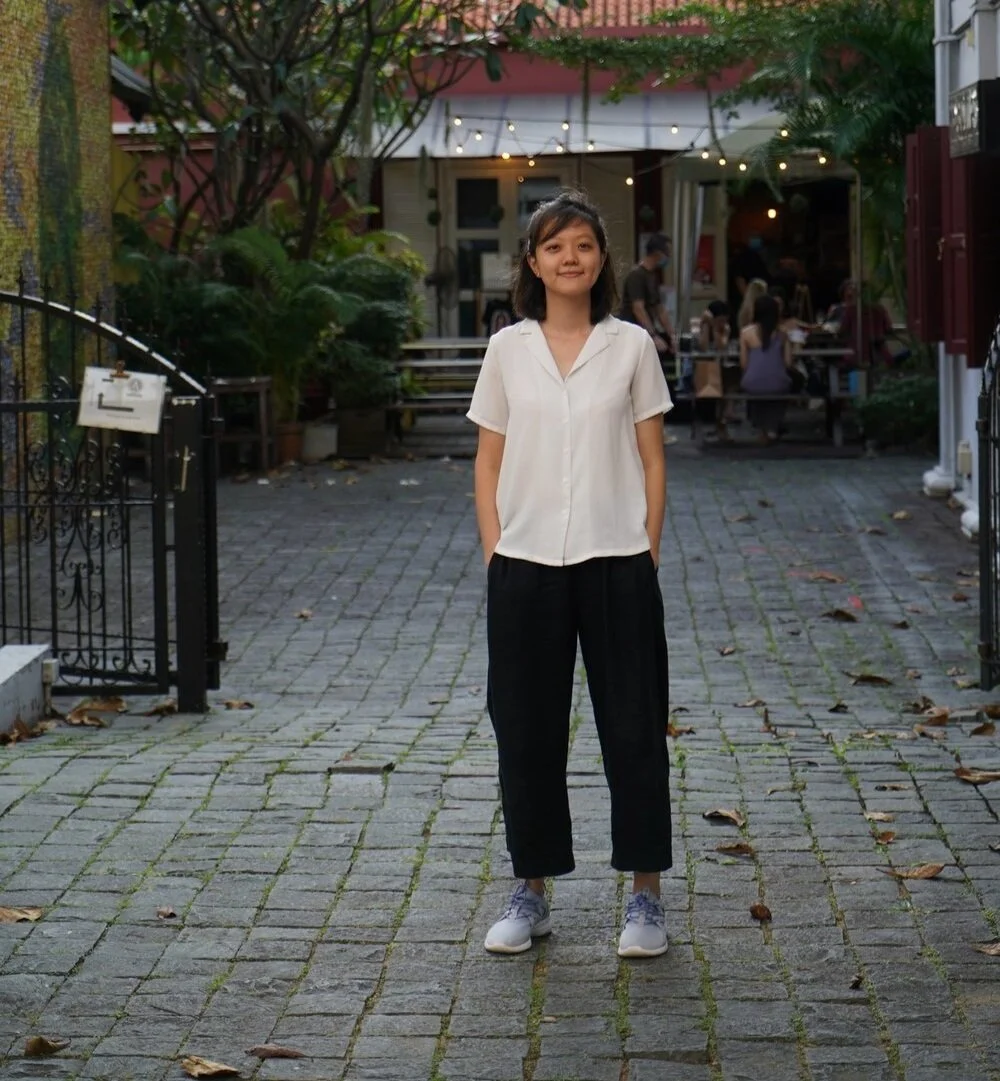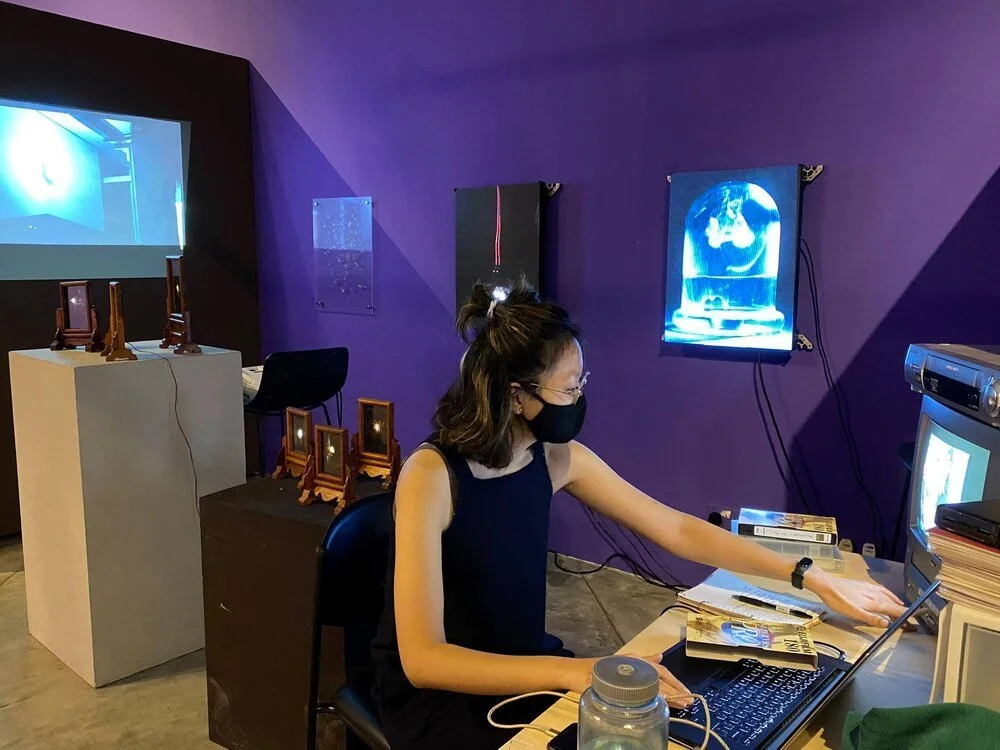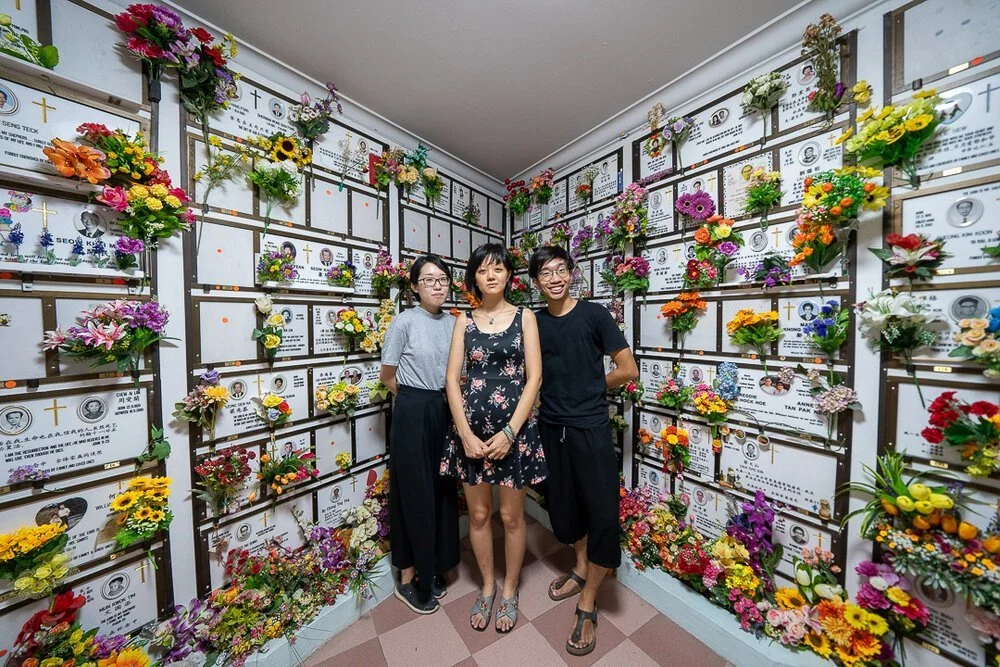Fresh Face: Adar Ng
Inanimate objects as vessels of memory
A&M's Fresh Face is where we profile an emerging artist from the region every month and speak to them about how they kick-started their career, how they continue to sustain their practice and what drives them as artists.
Adar Ng.
Adar Ng is a versatile media artist from Singapore who primarily works in photography and videography. The artist explores themes of impermanence using inanimate objects like VCR players or ancestral frames as entry points to philosophical ponderings on the transient nature of life. Through her work, Adar reminds her audience that though memories and experiences fade, there are trinkets that become metaphors of times past.
Adar Ng, The Light Bears Witness, 2019, exhibition installation view. Image courtesy of the artist.
Since graduating from the School of Art, Design & Media at Nanyang Technological University in 2018, Ng has exhibited widely showcasing her work in exhibitions at Singapore and abroad. Some exhibitions she has since participated in include THELASTMINUTESHOW, Bite/Hold/Release: The Boogeyman's Hand at Supernormal, Undescribed 4 at DECK, and the CDL Singapore Young Photographer Award. In 2020, Ng was one of eight artists-in-residence with Objectifs Centre for Photography and Film for their sixth annual Women in Film & Photography programme. She also has a few awards under her belt. She was one of the Top 10 Finalists in the Belgrade Photo Month New Talents 2019. In the same year, together with partner and fellow artist Dave Lim, she founded Third Street Studio, which offers a full suite of services to make creative video and photo works.
Adar Ng, My Mom Lives in a Dying Medium, 2019, exhibition installation view. Image courtesy of the artist.
In My Mom Lives in A Dying Medium, Ng transferred home footage of her mother from a laptop to a VCR player, which required video data to be written and rewritten from digital to analog systems. The artist observes how the loss of quality triggers reminiscence and creates a false sense of nostalgia. The work questions how technological aesthetics affects the sentimental imprint of memory and how this impacts the legacy of generations in the future. Another installation, Finitude (Numbered.) reinterprets the simile “moths to flames” to mean working without autonomy over our fate, destiny or mortality. Her use of time-based media elicits “existential dread” as viewers witness four light sources slowly dim, including a candle flame that flickers until oxygen in its dome runs out. Ng uses the imagery of the smoky dome and the pendulum of a hanging lamp losing momentum as an analogy to how no abundance of self-determination can erase the eventuality of death in a person’s life.
In Ng's artistic work, she expresses her interest in memory, both in its preservation and in its queries. She encapsulates the human condition through both extroverted social exchanges and introverted sentimental fixations.
Interview
Group Residency at Objectifs. Image courtesy of Objectifs.
Could you talk about your background? And at what point in your life did you decide to pursue a career in art?
I was exposed to the notion and idea of art through cinema and that was my entry into the beauty of expression and storytelling. I was studying film then in a local polytechnic. I couldn’t ignore the wonders that art offered and decided that I would be happy being around art and creativity.
Could you share how you’ve maintained your practice after graduation? What are the important factors that kept you going?
Art-making is at times a solo journey, but I count on the support systems in place in the community for my practice to thrive. For instance, I took part in a one-month long residency last November at Objectifs Centre for Photography and Film as part of their Women in Film & Photography programme. It was a wonderful opportunity to revisit and set up my works in their physical permutations, and to have great conversations with like-minded individuals.
Collaborations are also important for me to expand beyond my individual frame and mode of thinking, and to relate to other spheres of thoughts. This constantly challenges me to think beyond my comfort zone. In 2019, I co-organised the show BITE/HOLD/RELEASE with two other artists Quinn Lum and Lin Shiauyu. Working from our relationship with our mothers, we mounted a show on the premise of no longer having a mother in our lives to having one who cares too much. It was for this exhibition that the work My Mom Lives in a Dying Medium was birthed. As our works stemmed from our lived experiences, we held space for each other to listen and provide support.
Learning how to make dumplings with Shiauyu's mother. Image courtesy of the artist.
Visiting the artist’s mother’s niche. Image courtesy of the artist.
From VCR players in My Mom in a Dying Medium to motion sensor light bulbs in The Light Bear Witness, you have experimented with various unorthodox mediums across your body of work. What is your thought process like when selecting these mediums, and how do their materialities inspire your eventual works?
I primarily do not begin with the question of materiality. I usually start with an inkling of an emotion and an inquiry into that emotion. It is in the journey of making a piece of work that the medium is found and the concept is finalised. I arrived at the medium of video within the VCR Players & CRTV because I was led by my inquiry to find out more about my late mother beyond the photographs that I currently possess. The distrust I had with the visual similarities people found between us led me to a 3-month long search of engaging with mother figures. I had conversations with family members and close relatives about my mother. With what little I knew of her, I wanted to expand and paint a bigger picture of her. It wasn’t until I found VHS tapes of family events that I satisfied my curiosity. In these tapes, I could hear her voice and watch how she moved and behaved. As I tried digitising the footage, I noticed a drop in quality when viewing these older clips on modern devices. It looked and sounded best within its analog system of a display of CRTV. This led to more questions. What was lost when we made the leap from analog into our hyperreal digital future, for example? I meant this as both the loss in quality but also the loss in memories. This question eventually inspired my eventual work; where the experimentation of the transference process became the method of treatment of the videos.
Adar Ng, My Mom Lives in a Dying Medium’ 2019, exhibition installation view. Image courtesy of the artist.
Adar Ng, My Mom Lives in a Dying Medium, 2019, exhibition installation view. Image courtesy of the artist. More blacks are added in the border of video as letterboxing happens across screens that has different aspect ratio. This causes cascading effect where the original content becomes smaller with every round of transference.
When photographing or video recording for clients of your creative studio, Third Street Studio, how do you balance your artistic vision with the requirements of the project?
Making art and working for clients require different mindsets. Understanding the brief from clients and working within a specified framework is important. Although I would say that a lot of the sensibilities can be shared and brought over, there’s also a need to be in constant negotiation on how to deliver the best value for the clients instead of my own perspective of the “artistic”.
Third Street Studio working on Sekali Lagi!. Image courtesy of the artist.
BITE/HOLD/RELEASE (2019) at Supernormal, Desker Road. Image courtesy of the artist.
What was one important piece of advice you were given?
Have a sustainable art practice.
Could you share your favourite art space or gallery in your country? Why are you drawn to that space and what does it offer to you or your practice?
There are many exciting and evolving art spaces worth looking into in Singapore, and to make a decision to choose only one space would be difficult. I owe my current standing as an artist to many spaces. For example, both DECK and Objectifs, which are visual arts spaces dedicated to contemporary Photography locally and regionally, have given me many opportunities to show my works from my formative years as a student.
Another space I cherish would be Supernormal, an independent arts space that strives to present experimental and offbeat works. In their previous shophouse space at Desker Road, where BITE/HOLD/RELEASE was exhibited, we were given the liberty to experiment with the spatial representation of each of our works.
Adar Ng and Dave Lim, STICKI, 2021. Image courtesy of the artists.
What are your hopes for your own local art scene, and regionally as well?
Continued sustainable growth and expansion, to cultivate an art literate public keen to engage with creative projects.
Are there any upcoming exhibitions/projects that you would like to share more information on?
I co-curated and organised an exhibition ON/OFF/SCREEN at DECK with Alfonse Chiu and Dave Lim as a collective called MPEG, Moving Picture Experiment Group. It is a commission by Singapore Art Week, and will run untll 18 February 2021. Featuring eight artists, the exhibition attempts to explore the entanglements between reality, representation, and discourse, as facilitated by the variegating interpretations of the moving image.
And as part of the Light to Night Festival, Sticki (2021), co-created with my partner Dave Lim, will be on a train cabin plying the North-South and East-West line till 14 Februrary 2021.
And last but not least, The Spaces Between Us (2021), a documentary film also co-authored with Dave Lim will make its debut at the National Museum of Singapore exhibition Picturing the Pandemic. This will take place in February 2021.











